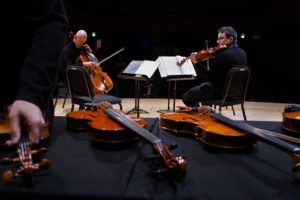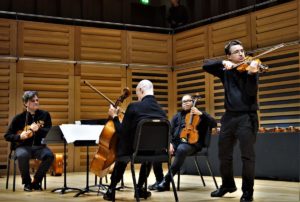On Sunday 3rd February, the Kreutzer Quartet spent an inspiring day at Kings Place. The British Violin Makers Association holds an annual Maker’s day at the arts complex, which is an opportunity for hundreds of makers, players and enthusiasts, to meet exchange ideas and to hear the extraordinary richness of making in this country.
I would like to thank Emma Hardy for taking the marvellous photos which you can see on this post!
This was, if nothing else, a salutory reminder that the health of any art is directly proportional to it’s exchange of ideas, and with music and music-making, that exchange of ideas is most healthy when it as international, outward-looking as possible. British lutherie, like any other, has always flowered in a European, and more recently, global context, and anyone who came to yesterday’s event hoping for a ‘Engerlish’, insular, outlook, a celebration of some kind of nationalism, would have been disappointed.
At the beginning of the day, makers were invited to submit their violins, violas and cellos to be played in the lunchtime concert. The quartet then had the enviable task of deciding which 20 instruments would be heard. We were keen to suggest that this was and is not a competition. There is nothing, in my mind, to be gained in art by pointing out why one thing is superior to another. However, there is much to be gained by exploring, relishing and learning from the fascinating variety of approaches to the question of ‘what is a violin’?

Mihailo Trandafilovski and Neil Heyde seen in the perpective of some of the new violins 3 2 19 photo Emma Hardy
As we were keen to stress in the Q&A which followed our performance on the instruments, every time one of us picks up a character-, timbre-. or colour-ful instrument, and learns how to play it, new possibilities are given to us. I learnt new shadings, pigments, articulations and affects which I can, and will, take with me, the next time that I pick up the Amati to practice this evening.
With the help of the very efficient and tireless team of assistants put together by Ben Hebbert, the chairman of the BVMA, we spent a fascinating few hours refining our choices of instruments. This involved playing, playing, playing. And playing is about listening.
One curiosity about the medium of the String Quartet is that it consists of three different instruments, and contrary to what is often thought, there is no difference between a ‘first violin’ and a ‘second violin’. In fact I refuse to use the word: you won’t find it on our programmes. However a quartet is, should be, a convocation, a parley-moot, a choir, consort, rabble or carousing of counterpointing, complimentary, contradictory, complementary, corroborating, collaborating, conspiring …. most importantly different characters. Mihailo Trandafilovski was a pains to point to the audience that he and I want different things from violins, and it was interesting that we, despite working through the same crowd of instruments, we did not end up fighting over any one fiddle. Whew.
This wonderful exercise in listening and triage complete, we then had the enviable ‘job’ of giving a concert with 5 different ensembles within 45 minutes. We were at pains to choose music which gave the opportunity to the instruments to do as many of the things which should be demanded. There is a tendency with the approach to violinmaking for less-experienced players to simply try and see what big, melodious, virtuoso material sounds like on an instrument. This is not very interesting, and not useful. (More on this later)
So we chose Quartets by Haydn (the ‘Lark’ Op 64 no 5), Mozart – (‘Prussian’ K590), Ravel, and an extraordinary realisation of Bach’s last work, the unfinished Contrapuntus XIX , by our great colleague and inspiration, Michael Finnissy. This last work, as we said, speaks to everything that is fascinating about any artform today. Isaac Newton’s ‘standing on the shoulders of gyantes’ has been much over- (and mis-) used, but it sums up what a great maker of today is doing – finding creativity, freedom, innovation, and invention in dialogue with the great convocation of players of makers and players that has gone before.
In between each of the quartet pieces, each of us introduced our chosen 5 instruments and found a different way to reveal something of their richness. Neil Heyde took a miniature pairing of Bach and Hindemith to open up the possibilities of the celli. Clifton Harrison used Schubert. Mihailo improvised, or rather composed ‘live’: it was fascinating to see how his finely crafted timbral study evolved over five iterations. I chose a different approach, playing different material on each instrument (de Machy, Bach, Prokofiev etc) . There’s no right way, but there is certainly various interesting ways to explore.
What pleased me the most was the real sense of appreciation of the craft. Spontaneous ‘oohs’ and ‘ahhs’, from the audience, involuntary responses to the various qualities and characteristics of each fiddle. This is what it’s all about. It was Peter Greenaway who said ‘Great architecture should always be applauded’, and I would replace this with ‘Great Making’ : and it was. At the end of the concert, all the makers thronged the stage to rescue (!) their instruments, and receive the applause and thanks which is their due.
In the post-concert Q & A, there was a lot of discussion as to what players look for in a new instrument. It was suggested, from the audience, as we developed our theme, that the sound/timbre based technique for assessing instruments was something which should be taught. That’s a very good point, and one which I would argue should be a topic across all pedagogy. Certainly, in the string world. there is a tendency, in teaching, to regard the questions of colour as ‘final touches’ in the question of technique, and an overview of the literature for teaching the violin will bear this out.
We said, early in the concert, that the most exciting thing about a day like this for us, is learning from te extraordinary variety of ‘Stoff’ which new instruments can offer players. I am thinking back and remembering the snarl offered by the G string of one violin, or the delicacy on the E that I discovered on the first fiddle that I played in the concert-and these are just two small examples.
Because, and this is crucial, one can only really discover what an instrument is capable of, when people are listening, and most important, when they are listening in a concert setting. Yes, it is very useful to ‘try a violin out’ with an extra pair of ears in the room: But, this will not enable the extraordinary shared activity of music-making, the alchemy between composer-instrument-player-audience-space, to take wing. The full range of expression which we can achieve only happens then; that is what we reach for, and what we reach for is transcendence. I think that one of the reasons that we love the work of luthiers and archetiers, is that, even before we put bow to strings, and are just looking at, or holding a violin, the ‘finis precieux’ of string instruments offers such a quality, in the extraordinary balance between imagination, architecture and materials. That’s the excitement, and the challenge set for us all, by the art of the violin maker. It’s a privilege to set these wonders ringing and singing.
Standards
I could not help but note, that, in every way, the standards which we have come to expect from makers have risen in the past few decades. I did not attempt a rationale for this, but in the questions which followed the concert, Ben Hebbert offered a useful part-explanation for this. He pointed to this as a legacy of The Strad magazine posters, which offered detailed information/plans for the great instruments, as well as ever-improving photographs. At the very least, this means that every aspiring maker has had decades of access to more information and inspiration for their work from the makers of the past than was ever available to nearly everyone. Having recently acquired an early edition of Heron-Allen’s epochal Violin-Making As it Was and Is (1885), which was ground-breaking in its making available of simple blue-prints to makers, it is very clear to me that Ben is right. And players today re reaping the benefits – as was clear from the number of players who had come to the event looking to buy an instrument!

Each of the Kreutzers took few minutes to demonstrate their choice of 5 violins. Here, Mihailo Trandafilovski improvises 3 2 19 photo Emma Hardy
Historical set-up?
One issue which came up in the post-concert event was the range of set-ups which a modern player uses, and how makers might work with that. I was interested to see that the expectation was, in 90% od cases, that players would be expecting ‘modern’ setup, and that in most cases, that involved quite high-tension stringing. I pointed out that a large portion of players today (myself included) work across the HIP/modern divide, which is increasingly friable anyway. This means that players will be looking for a range of possibilities from their instruments, including fiddles which can accommodate various combinations of strings, fittings, and bows. This also has a signal impact on the range of timbre and colour which players will seek out in any instrument.
…further to my previous note, it’s worth adding that the kaleidoscopic demands of the music of our time also figure into the expectations of players from their instruments. I don’t mind admitting that, for instance, if I am playing music which demands extreme clarity (and reachability) of upper harmonics, I am most likely to reach for my Hill 1900 violin, than any of the earlier instruments which I play. I know that this instrument will deliver this material with a macrometer-level of acuity, and with no loss of body or timbre. Looking around the players who I could see at the BVMA day, there were a good proportion who are devoted to the music of our time, and will be demanding these qualities.
The Composer speaks
…and it was fascinating for me to watch/listen to composer/violinist Mihailo Trandafilovski work his way, live, through the instruments he had chosen to play. Mihailo’s music is all about finding ways to sing, through ringing, juxtaposition, harmonics, tremoli, trills, open and closed notes, and a very clear dialogue with the natural world and his Balkan heritage. His little studies, which, as I noted, evolved over the few minutes that he was alone on stage, are models of how to explore the possibilities from a personal point of view.
The Viola point of view
As Clifton Harrison noted, on of the real challenges in this situation is that every single viola is different, One might argue that the very question of ‘what is a viola?’ is something that makers are answering in a huge variety of (sometimes strikingly different ) ways each time they make an instrument. This results in not only great variety of size and stop length, but also in the configuration of instruments, the angle which they demand to be held, nut placement for the left hand, rib height, and fingerboard design. For the player, every instrument is an adventure!



















Posted on February 3rd, 2019 by Peter Sheppard Skaerved